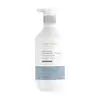What's inside
What's inside
 Benefits
Benefits

 Concerns
Concerns

No concerns
 Ingredients Side-by-side
Ingredients Side-by-side

Aloe Barbadensis Leaf Juice
Skin ConditioningCoco-Betaine
CleansingSodium Cocoyl Glycinate
CleansingLauryl Glucoside
CleansingPolyquaternium-10
Sclerocarya Birrea Seed Oil
HumectantArgania Spinosa Kernel Oil
EmollientVitis Vinifera Seed Oil
EmollientCetyl Alcohol
EmollientPhenoxyethanol
PreservativeSesamum Indicum Seed Oil
EmollientCarbomer
Emulsion StabilisingHydroxypropyl Guar
Emulsion StabilisingDisodium EDTA
Citric Acid
BufferingAloe Barbadensis Leaf Juice, Coco-Betaine, Sodium Cocoyl Glycinate, Lauryl Glucoside, Polyquaternium-10, Sclerocarya Birrea Seed Oil, Argania Spinosa Kernel Oil, Vitis Vinifera Seed Oil, Cetyl Alcohol, Phenoxyethanol, Sesamum Indicum Seed Oil, Carbomer, Hydroxypropyl Guar, Disodium EDTA, Citric Acid
Ingredients Explained
These ingredients are found in both products.
Ingredients higher up in an ingredient list are typically present in a larger amount.
Disodium EDTA plays a role in making products more stable by aiding other preservatives.
It is a chelating agent, meaning it neutralizes metal ions that may be found in a product.
Disodium EDTA is a salt of edetic acid and is found to be safe in cosmetic ingredients.
Learn more about Disodium EDTALauryl Glucoside sugar- and lipid-based cleansing agent. It is created from glucose and lauryl alcohol.
This ingredient is a surfactant, making it easier to rinse oil, dirt, and other pollutants away.
A British study found lauryl glucoside to cause skin sensitivity for some people. We recommend speaking with a professional if you have concerns.
Other names for this ingredient include "Lauryl Polyglucose", "Lauryl glycoside", and "D-Glucopyranoside".
Learn more about Lauryl GlucosideSodium Cocoyl Glycinate is a cleansing agent. It can be naturally derived or synthetically-created.
As a surfactant, it helps clean your skin by gathering dirt, oil, and other pollutants to be rinsed away more easily.